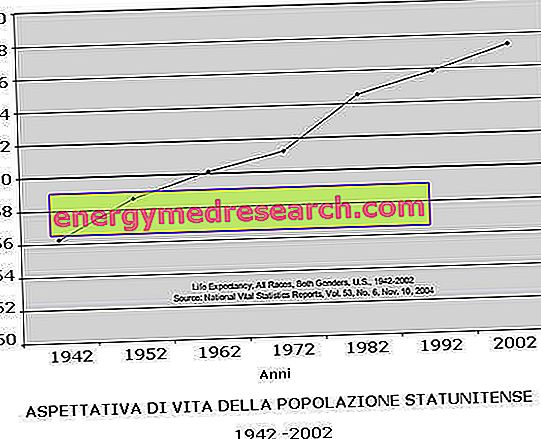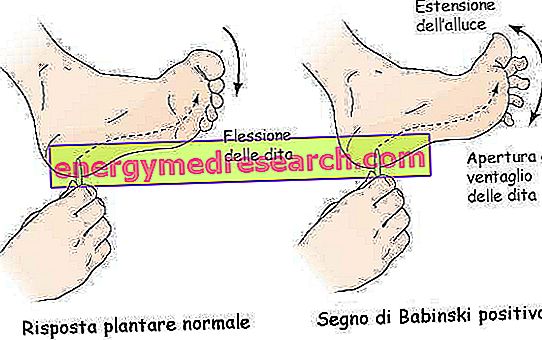Generality
Erythrocyte sedimentation rate ( ESR ) is an inflammatory index .
As its name suggests, this test measures the speed with which erythrocytes (red blood cells) - present in a blood sample made uncoagulable - settle at the bottom of the tube that contains them. The facing is expressed in millimeters of sediment produced in an hour.

It should be noted that the ESR is a non-specific index (ie generic) and must be interpreted in the context of other targeted clinical investigations. In other words, if the other parameters are in the norm, the finding of a high ESR value must not cause concern.
What's this
VES is the acronym of "erythro-sedimentation speed", a blood test introduced in the diagnosis around the 20s of the last century.
In blood, red blood cells tend to remain in suspension, separated from each other thanks to the negative membrane charge that hinders the formation of aggregates (rouleaux).
Under normal conditions, the protein component of the plasma is such as to preserve the surface charge of the red blood cells. On the contrary, when inflammatory processes are established in the body, the increased blood concentration of proteins typical of inflammation (including fibrinogen and C-reactive protein) leads to a weakening of repellent forces. Red blood cells, as a result, tend to aggregate, with the formation of rouleaux with a high tendency to precipitate. The coarser these clusters are, the faster the sedimentation is.
The ESR, precisely, measures the sedimentation rate of the red blood cells in the plasma, in mm per hour, when the blood sample is left to rest in a special pipette.
According to the above, the ESR represents a non-specific index of phlogosis; it is not surprising, therefore, that it increases in rheumatic diseases, in chronic infections and in diseases with fatal course, such as malignant tumors with metastases.
| Age (years) | Average ESR (Mm / h) | Range (Mm / h) | |
| Men | 20-49 | 5 | 0-13 |
| 50-69 | 7 | 0-19 | |
| Women | 20-49 | 9 | 0-21 |
| 50-69 | 12 | 0-28 |
Why do you measure
Erythrocyte sedimentation rate (ESR) is a simple test, which provides general information about the presence or absence of inflammation and which indirectly measures its extent.
The progress of the ESR also makes it possible to monitor the course of an already diagnosed disease.
Inflammation is a part of the body's immune response. This can be acute, developing rapidly (for example, after an injury or during an infection) or it can last ( chronic ) in the presence of diseases such as autoimmune diseases or cancer.
The erythrocyte sedimentation rate is a parameter used as a support in revealing the inflammation associated with some diseases, such as:
- Infections;
- tumors;
- Autoimmune disorders.
The ESR is a non-specific test: high results often indicate the presence of inflammation without indicating to the doctor exactly where this inflammation is located and what is caused.
For this reason, it is usually used in combination with other tests, such as the C reactive protein assay (PCR), the antinuclear antibodies (ANA), the rheumatoid factor, fibrinogen and other generic tests, such as the total metabolic panel or the blood count with formula.
When is the exam indicated?
The erythrocyte sedimentation rate is measured to determine the presence of an inflammation, which can be caused by one or more conditions or diseases, such as: infections, tumors or autoimmune diseases.
Furthermore, the examination is useful to support the diagnosis and monitor the course and therapeutic response of specific diseases, including: transient arthritis, systemic vasculitis, rheumatoid arthritis and systemic lupus erythematosus (SLE).
The doctor may prescribe this examination when the patient has signs and symptoms that can be associated with inflammation, such as:
- Headache;
- Pain in the knees and shoulders;
- Pelvic pain;
- Anemia;
- Poor appetite;
- Unexplained weight loss;
- Joint stiffness.
Normal values
Under normal conditions, the ESR value is about 10-20 mm per hour.
With age, the ESR shows a slow but definitive increase, even in clinically healthy subjects, for which the normal ranges vary in relation to the age group. In women, the values are slightly higher than in men.
The maximum values of VES considered normal are expressed by the Miller formula:

High ESR - Causes
As anticipated, an increase in the Erythrosedimentation Speed suggests the presence of an ongoing inflammation, even if it does not tell us anything about its nature.
Consequently, the extent of the ESR is proportional to that of inflammation, but not necessarily to the severity of the disease.
Another major limitation is that the ESR can be normal even if the infection is already in place, or it can be elevated when you have already healed. The attenuation of erythrocyte negative charges by means of the aforementioned phlogosis proteins is not in fact immediate, but takes a few days. Similarly, the normalization of values is also late.
Among the various factors that influence the values of the ESR in a positive or negative sense (see table), anemia is the main element of disturbance. The ESR is in fact inversely proportional to the hematocrit, so it is high in anemia conditions. The shape and volume of the red blood cells also influence the erythrocyte sedimentation rate, since spherocytes and microcytes (red blood cells, respectively, spherical in shape and smaller than normal) sediment more slowly.
High ESR values are also recorded in tissue necrosis (for example following a trauma), during pregnancy and in some lymphoproliferative diseases in which one or more immunoglobulins are secreted in high concentrations.
| Factors that influence the ESR | |
| Anemia; Hot; High MCV (macrocytes), congenital hyperproduction of an α-globulin | VES increased |
| polycythemia; cold; Low MCV (microcytes) | VES decreased |
A mild to moderate rise in the ESR - not attributable to particular diseases - should lead to a repeat test after a few months, rather than undertaking an expensive search for occult disease.
Some medicines can increase the ESR, such as dextran, methyldopa, oral contraceptives, procainamide penicillamine, theophylline and vitamin A. In women, menstruation and pregnancy can cause a temporary rise in the parameter.
Low ESR - Causes
The erythrocyte sedimentation rate appears lower than normal in the presence of sickle cell anemia, polycythemia and heart failure. Damage to the liver - an organ responsible for the synthesis of plasma proteins including those of inflammation - can decrease ESR values even in the presence of concomitant pathologies that normally elevate their values. A similar result in the presence of malnutrition.
Certain drugs such as aspirin, cortisone and quinine may decrease the ESR.
If the ESR value is quite low - close to 0 mm per hour - the cause can be an allergy or a dehydrated state of the organism.
How to measure it
For the analysis of the erythrocyte sedimentation rate it is necessary to take blood from a vein in the arm.
The ESR test measures, in particular, the time it takes for erythrocytes (red blood cells) to precipitate (sediment) into a blood sample placed in a long, narrow test tube of standard height.
The result is reported in millimeters of fluid (plasma) that are present in the upper portion of the tube after one hour.
When a blood sample is placed in the test tube, the cells normally settle relatively flat, leaving the plasma clearer.
Red blood cells settle more quickly in the presence of an increased concentration of protein in the blood in response to inflammation, particularly those called "acute phase" (such as the C reactive protein and fibrinogen).
Preparation
The patient can undergo blood sampling after fasting for at least 3 hours.
Usually, drugs do not affect the result, but it is always advisable to inform the doctor about a possible therapy in progress, so that he can have an overall idea of the state of health in which the person is.
Interpretation of Results
The ESR result is reported in millimeters of fluid (plasma) present in the upper portion of the standard height tube after one hour (mm / hour). Being a non-specific marker of inflammation, the outcome of the examination must be compared to other clinical findings, the patient's symptoms and the results of other investigations of further study.
After evaluating the complete picture, the doctor will be able to confirm or discard the suspected diagnosis.
High ESR
- Without any symptom indicative of a specific pathology : usually, the ESR does not provide enough information to make medical decisions. Furthermore, a normal result cannot exclude inflammation or other conditions.
- Moderately high ESR : values close to or slightly higher than 20 millimeters in 1 hour, are found in case of pregnancy or in the course of an infection caused by bacteria (such as, for example, pharyngitis) or anemia, but also in old age.
- Very high ESR : it can be determined by an inflammatory state such as rheumatoid arthritis, by a liver disease, by a renal insufficiency, by a trauma and so on, up to make to suspect the presence of a tumor when the value is superior to 100 mm after 1 hour.
When a disease is monitored over time, the increase in ESR may indicate an increase in inflammation or a poor response to therapy; a normal or decreased ESR may indicate an appropriate response to treatment.
Low ESR
A low ESR can be observed in those pathologies in which the normal sedimentation of red blood cells is inhibited, as in the presence of: polycythemia, leukocytosis and in some diseases characterized by protein abnormalities.
Even in pathologies characterized by abnormalities of the shape of red blood cells (such as in sickle cell disease in which the red blood cells have a sickle shape) a low VES can be found.
Reduced erythrocyte sedimentation rate is also found in the presence of allergies and dehydration.
| Diseases that influence the ESR | |
| Anemia, endocarditis, kidney disease, osteomyelitis, pregnancy, rheumatic fever, rheumatoid arthritis, systemic lupus erythematosus, syphilis, thyroid disease, tuberculosis, mononucleosis, other inflammatory conditions. | VES increased |
| Systemic infections (septicemia); giant cell arteritis; multiple myeloma; hyperfibrinogenemia; macroglobulinemia; necrotized vasculitis; rheumatic polymyalgia. | VES very increased |
| Heart failure, polycythemia, hyperviscosity, low plasma protein (due to liver damage), hypofibrinogenemia, sickle cell anemia. | VES decreased |



